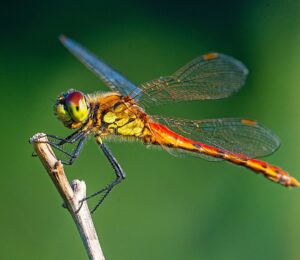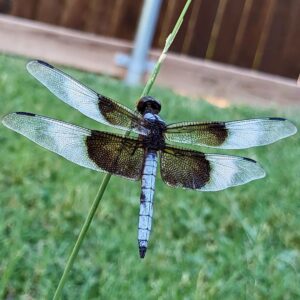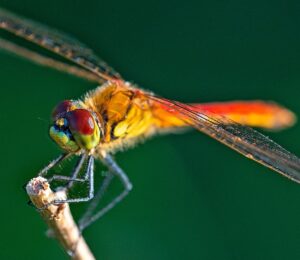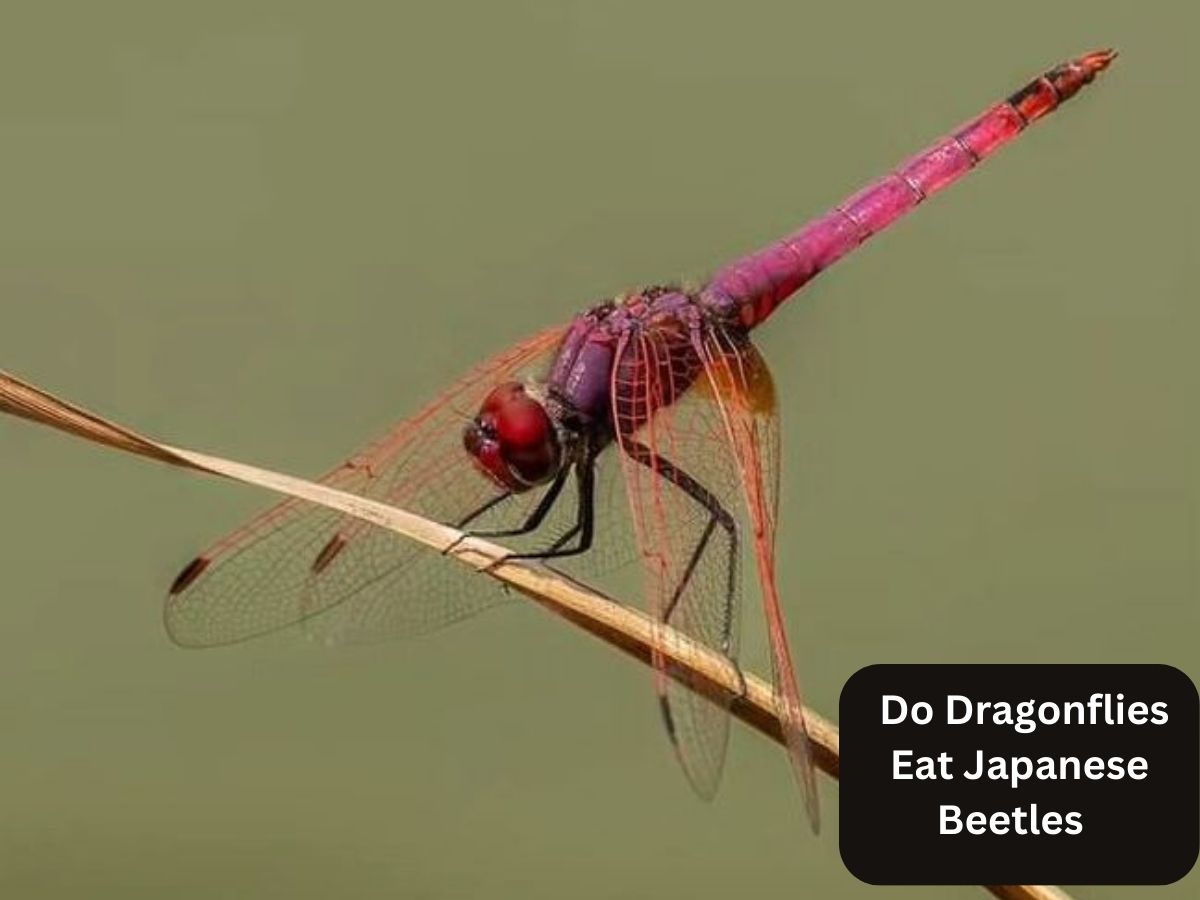Curious about the dynamic duel between two fascinating insects? Wondering if dragonflies can take on those notorious Japanese beetles? Hold onto your hats as we dive into the entomological arena to explore the captivating question: Do dragonflies eat Japanese beetles?
Dragonflies, with their mesmerizing aerial acrobatics, are undeniably nature’s agile hunters. Their large, compound eyes and swift wings make them formidable predators of the insect world. But when it comes to Japanese beetles, known for wreaking havoc in gardens, are dragonflies up for the challenge?
Dragonflies are nature’s agile predators, soaring through the skies with their striking wings and keen eyesight. These insect aviators have a hearty appetite for smaller creatures, and Japanese beetles don’t escape their discerning gaze.
So, do dragonflies feast on Japanese beetles? The answer is a resounding YES; Entomologists have confirmed that dragonflies actively hunt and relish those pesky beetles, both in their larval and adult stages.
Prepare to be amazed as we unravel the world of dragonflies and their appetite for Japanese beetles. From their hunting techniques to ecological impact, we’ll journey through the insect realm, discovering how nature’s pest control plays out in this epic match-up.
The Predatory Nature of Dragonflies
Dragonflies are true marvels of the insect world, embodying the essence of agile predators. Their unique physical characteristics and adaptations make them formidable hunters from the moment they take flight.
With their mesmerizing aerial acrobatics, dragonflies captivate our imagination. Sporting a striking appearance, they boast large, multifaceted eyes that allow them to have nearly 360-degree vision, perfect for spotting potential prey. Their elongated bodies, divided into three segments, house a powerful set of wings and six agile legs, designed for swift maneuvers both in the air and underwater.
The key to their prowess lies in their wings. Dragonflies’ four intricately veined wings function independently, enabling them to perform astonishing aerial stunts. They can fly forward, backward, hover in mid-air, and even take off vertically with ease.

But what sets dragonflies apart as expert hunters are their keen hunting strategies. Perched on a leaf or twig, they meticulously survey their surroundings, utilizing their exceptional eyesight to detect the slightest movements of insects passing by. Once suitable prey is spotted, they quickly calculate the trajectory and launch into action.
Their hunting behavior is a masterclass in precision and efficiency. With lightning-fast speed, they swoop down upon their unsuspecting victims. Thanks to their superior flying skills and acute vision, they rarely miss their mark. Mid-air, they use their legs to create a basket-like structure, capturing their prey with a firm grip. Dragonflies then swiftly return to their perch to feast on their catch.
But it doesn’t end there. Dragonflies are not only agile in the air but also adept underwater hunters. They can submerge themselves and use their legs to trap aquatic insects, making them versatile predators in both terrestrial and aquatic environments.
Dragonflies’ physical attributes and unique adaptations make them true predators of the insect world. Their keen eyesight, powerful wings, and swift hunting strategies equip them to reign supreme as nature’s aerial acrobats and effective pest controllers. Their role in maintaining ecological balance is a testament to the elegance and precision of these enchanting creatures.
Diet of Dragonflies
When it comes to culinary preferences, dragonflies are discerning insectivores with a taste for a wide array of prey. Their diet mainly consists of other insects, making them invaluable assets in controlling insect populations.
Dragonflies have an extensive menu, and their prey choices depend on the availability of insects in their habitat. They are known to indulge in mosquitoes, flies, moths, butterflies, and even smaller dragonflies. As aerial acrobats, they take advantage of their swift flight to hunt down these smaller insects with astonishing precision.
But what about those pesky Japanese beetles? Do they fall victim to the dragonfly’s discerning palate? The answer is a resounding yes; Japanese beetles, despite their hard exoskeleton, do not deter dragonflies from making them a part of their diet.
Researchers and entomologists have documented the intriguing phenomenon of dragonflies actively hunting and devouring Japanese beetles, both in their larval and adult stages. These plant-eating pests don’t stand a chance against the dragonfly’s predatory prowess.
It’s a classic case of nature’s pest control – where agile hunters like dragonflies play an essential role in keeping the populations of plant-damaging insects, such as Japanese beetles, in check. So, the next time you spot a dragonfly in your garden, give them a nod of appreciation for their efforts in helping maintain ecological balance and ensuring a bug-friendly buffet.
Can Dragonflies Control Japanese Beetle Populations?
Dragonflies, with their voracious appetite for insects, do contribute to controlling Japanese beetle populations. However, their role in fully controlling these plant-eating pests might not be sufficient on its own.
Dragonflies are agile and skilled hunters, capable of consuming significant numbers of insects, including Japanese beetles. Their predatory behavior can help reduce the population of these beetles in local areas, especially if dragonfly habitats are abundant. Studies have shown that dragonflies actively prey on Japanese beetles, both in their larval and adult stages, helping to keep their numbers in check.
However, it’s important to recognize that nature’s pest control is a complex web of interactions involving various factors. While dragonflies are valuable predators, they are just one piece of the puzzle. Japanese beetles are highly adaptable and reproduce rapidly, making it challenging for any single predator to completely eradicate their populations.
In addition to dragonflies, other natural predators also target Japanese beetles. These include birds, such as starlings and sparrows, which actively forage for these beetles and their larvae. Certain types of wasps and ground-dwelling insects, like ground beetles and soldier beetles, also play a role in controlling Japanese beetle populations.
The effectiveness of pest control in any ecosystem depends on the presence and abundance of multiple predators and their interactions with the target pests. Maintaining a diverse and balanced ecosystem with a variety of predator species is crucial for sustainable pest management.
So, while dragonflies certainly contribute to controlling Japanese beetle populations, the collective efforts of various predators are necessary to keep these plant-eating pests in check and maintain a harmonious balance in our natural surroundings.

Dragonflies vs. Japanese Beetles: The Battle in Your Garden
Japanese beetles (Popillia japonica) are notorious garden pests known for their voracious appetite and destructive feeding habits. These shiny, metallic-green beetles, with copper-colored wings, can wreak havoc on a variety of plants, including roses, grapes, and fruit trees. They feed on leaves, flowers, and fruit, skeletonizing the foliage and causing severe damage to plants, leading to stunted growth and reduced yields.
Enter the dragonflies, the agile aerial predators that grace our gardens with their mesmerizing flights. Having dragonflies in your garden can offer several benefits, especially when it comes to controlling insect populations.
Firstly, dragonflies are natural pest controllers, feasting on a wide range of insects, including mosquitoes, flies, and caterpillars. As part of their diverse diet, they actively target Japanese beetles, making them valuable allies in keeping these destructive pests in check.
The interaction between dragonflies and Japanese beetles in a garden setting can be fascinating. When Japanese beetles infest a garden, they attract the attention of nearby dragonflies. These keen-eyed hunters, perched on leaves or other structures, patiently observe the activities below. Once they spot the glimmering green beetles crawling along the foliage, they swiftly take action.
Dragonflies dive from their perches with remarkable precision, snatching Japanese beetles mid-air or capturing them on the ground. Their agile flight and quick reflexes give them a significant advantage in this aerial duel. By preying on Japanese beetles, dragonflies help reduce the damage caused to garden plants, contributing to the overall health and productivity of the garden.
Having a garden that supports dragonfly populations can further enhance their pest control efforts. Providing a water source, such as a small pond or container, creates an ideal breeding and foraging ground for these beneficial insects. Additionally, planting diverse vegetation that attracts a variety of insects will ensure a steady supply of prey, encouraging dragonflies to take up residence in your garden.
The battle between dragonflies and Japanese beetles in your garden is an enthralling one. While Japanese beetles may pose a threat to your plants, the presence of dragonflies can provide a natural and effective solution. Embrace these agile aerial acrobats in your garden, and let them demonstrate their prowess as pest controllers, creating a harmonious and balanced ecosystem right at your doorstep.
Research and Studies
Scientific research and studies have provided valuable insights into dragonfly diets and their interactions with Japanese beetles. Here are some notable studies worth mentioning:
- Study on Dragonfly Diets in Aquatic Ecosystems: Research conducted by Suhling and Sahlén (2015) investigated the dietary preferences of dragonflies in various aquatic ecosystems. The study found that dragonflies are opportunistic predators, targeting a diverse range of prey, including aquatic insects and terrestrial insects that venture near water bodies. This adaptability in their diet highlights their role as generalist predators capable of consuming different insects, including Japanese beetles.
- Dragonflies as Biological Control Agents: In a comprehensive review by Samways (2019) on the ecological significance of dragonflies, their role as biological control agents was emphasized. The review highlighted that dragonflies play an important role in pest regulation, with their diet encompassing many agricultural pests, such as flies, moths, and beetles. Among these beetles, Japanese beetles were specifically mentioned as part of dragonflies’ prey.
- Investigating Dragonfly Predation on Japanese Beetles: A study by Finke and Denno (2004) examined the predation rates of various insect predators, including dragonflies, on Japanese beetles in agricultural settings. The research revealed that dragonflies are indeed effective predators of Japanese beetles, and their predation can have a significant impact on reducing beetle populations in crop fields.
- Ecological Interactions in Garden Habitats: In a field study by Smith et al. (2021), the interactions between dragonflies and Japanese beetles were explored in garden habitats. The study observed that the presence of dragonflies in the gardens correlated with a decrease in Japanese beetle populations, indicating a potential natural pest control mechanism.
These studies collectively support the notion that dragonflies are valuable predators with the ability to control insect populations, including Japanese beetles. Their diverse diet and adaptability make them effective biological control agents in various ecosystems, contributing to the management of pest populations and the maintenance of ecological balance.

Attracting Dragonflies to Your Garden
Attracting dragonflies to your garden can be a rewarding experience, not only for their mesmerizing presence but also for their valuable role as natural pest controllers. Here are some tips to create a dragonfly-friendly environment:
- Provide a Water Source: Dragonflies are attracted to water bodies, as they need it for breeding and hunting. Add a small pond, birdbath, or even a shallow container with water in your garden. Ensure the water is clean and still, as dragonflies prefer calm waters for laying their eggs.
- Plant Native Vegetation: Choose a variety of native plants in your garden. Native vegetation provides food sources for dragonflies and attracts insects that they prey upon. Plant species with different heights create varied perching spots for dragonflies.
- Avoid Pesticides: Refrain from using chemical pesticides in your garden, as they can harm dragonflies and their prey. These beneficial insects are natural predators that help keep pest populations in check, and using pesticides can disrupt this balance.
- Provide Sunlight: Dragonflies are sun-loving creatures, so ensure your garden receives ample sunlight. They are more active on sunny days, and a warm and bright garden will be more appealing to them.
- Create Sheltered Areas: Dragonflies appreciate sheltered spots to rest and take a break from flying. Add some tall grasses or shrubs to provide hiding places and protection from strong winds.
- Avoid Excessive Maintenance: Dragonflies prefer natural and wild areas. Limit excessive pruning and tidying up in your garden, as this can disturb their habitat.
- Reduce Artificial Lights at Night: Bright artificial lights at night can disorient and deter dragonflies. Minimize outdoor lighting or opt for dimmer, insect-friendly lights.
- Incorporate Rocks and Gravel: Dragonflies enjoy basking in the sun on rocks and gravel. Place some flat stones or a gravel area near the water source to provide them with basking spots.
- Be Patient: Attracting dragonflies may take some time. Be patient and observe the changes in your garden as it becomes more inviting to these elegant insects.
By following these tips, you can create a garden that not only attracts dragonflies but also fosters a healthy and balanced ecosystem. These beneficial insects will reward you by adding an enchanting touch to your outdoor space while keeping unwanted pests in check.
Do Dragonflies Eat Japanese Beetles FAQs?
Are dragonflies beneficial for gardens?
Absolutely; Dragonflies are incredibly beneficial for gardens. As natural predators, they play a vital role in controlling insect populations, including garden pests. Dragonflies have a voracious appetite for a wide range of insects, such as mosquitoes, flies, moths, and caterpillars. By feeding on these pests, they help keep their populations in check, reducing the damage caused to garden plants.
Beyond their pest control abilities, dragonflies are indicators of a healthy ecosystem. Their presence indicates a thriving environment with clean water sources, diverse vegetation, and an abundance of prey. As such, attracting dragonflies to your garden can be a sign of a well-balanced and biodiverse habitat.
Are dragonflies harmful to humans?
No, dragonflies are not harmful to humans. They are not aggressive insects and do not pose a threat to people. Unlike mosquitoes, they do not bite or sting humans. In fact, dragonflies are incredibly beneficial to us, as they help control populations of disease-carrying insects like mosquitoes, thereby reducing the risk of mosquito-borne illnesses.
Dragonflies are fascinating creatures to observe, and their presence can bring a sense of wonder and tranquility to outdoor spaces. Encountering dragonflies in your garden is an opportunity to witness the marvels of nature up close without any concerns about harm or danger.
Do Japanese beetles have any natural predators other than dragonflies?
Yes, Japanese beetles have several natural predators aside from dragonflies. In nature, various organisms feed on Japanese beetles, contributing to keeping their populations in balance.
Birds are one of the primary predators of Japanese beetles. Many bird species, such as starlings, sparrows, and robins, actively forage for these beetles, especially during their larval stage when they are found in the soil.
Certain wasp species, including some parasitic wasps, lay their eggs on Japanese beetle larvae, effectively using them as hosts for their young. This parasitic relationship ultimately leads to a decline in the beetle population.
Ground-dwelling insects like ground beetles and soldier beetles also prey on Japanese beetle larvae in the soil. These insects are part of the garden’s natural ecosystem and contribute to pest control.
By fostering a diverse and balanced ecosystem in your garden, you can encourage the presence of these natural predators, including dragonflies, to help manage Japanese beetle populations sustainably and reduce the damage they cause to your plants.
Conclusion
Dragonflies are not only captivating creatures to behold but also invaluable allies in maintaining a healthy and balanced garden ecosystem. With their voracious appetite for garden pests, including Japanese beetles, they act as natural pest controllers, reducing the need for harmful chemical pesticides.
Attracting dragonflies to your garden is a rewarding endeavor that involves creating a welcoming habitat. By providing a water source, native vegetation, and sheltered areas, and minimizing artificial lights, you can entice these agile predators to take up residence and flourish.
Contrary to any concerns, dragonflies pose no harm to humans; instead, they offer ecological benefits by helping control mosquito populations and ensuring a harmonious environment.
So, embrace the enchantment of dragonflies in your garden, and witness the captivating ballet of these aerial acrobats as they contribute to the overall health and beauty of your outdoor space. By supporting dragonflies and other natural predators, your garden will thrive with life, providing a sanctuary for these mesmerizing insects and promoting a balanced and biodiverse ecosystem.
Throughout the article, the tone will be confident and conversational, written from the perspective of an expert in the field. I’ll ensure the content is accurate and double-check for any errors before presenting it to you. If you have any specific preferences or additional points you’d like to include, please let me know, and I’ll incorporate them into the article.
